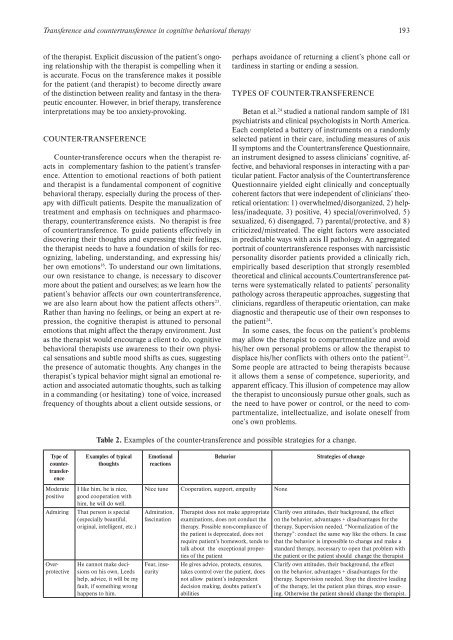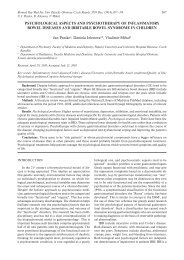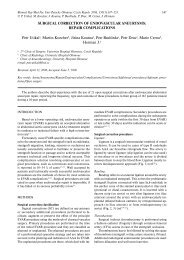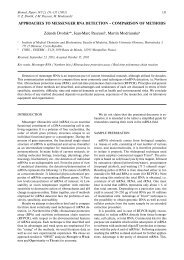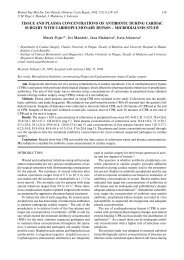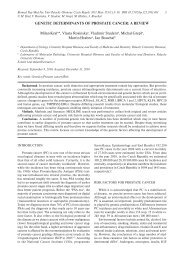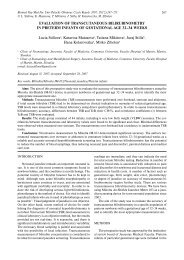Transference and countertransference in cognitive behavioral therapy
Transference and countertransference in cognitive behavioral therapy
Transference and countertransference in cognitive behavioral therapy
Create successful ePaper yourself
Turn your PDF publications into a flip-book with our unique Google optimized e-Paper software.
<strong>Transference</strong> <strong>and</strong> <strong>countertransference</strong> <strong>in</strong> <strong>cognitive</strong> <strong>behavioral</strong> <strong>therapy</strong>193of the therapist. Explicit discussion of the patient’s ongo<strong>in</strong>grelationship with the therapist is compell<strong>in</strong>g when itis accurate. Focus on the transference makes it possiblefor the patient (<strong>and</strong> therapist) to become directly awareof the dist<strong>in</strong>ction between reality <strong>and</strong> fantasy <strong>in</strong> the therapeuticencounter. However, <strong>in</strong> brief <strong>therapy</strong>, transference<strong>in</strong>terpretations may be too anxiety-provok<strong>in</strong>g.COUNTER-TRANSFERENCECounter-transference occurs when the therapist reacts<strong>in</strong> complementary fashion to the patient’s transference.Attention to emotional reactions of both patient<strong>and</strong> therapist is a fundamental component of <strong>cognitive</strong><strong>behavioral</strong> <strong>therapy</strong>, especially dur<strong>in</strong>g the process of <strong>therapy</strong>with difficult patients. Despite the manualization oftreatment <strong>and</strong> emphasis on techniques <strong>and</strong> pharmaco<strong>therapy</strong>,<strong>countertransference</strong> exists. No therapist is freeof <strong>countertransference</strong>. To guide patients effectively <strong>in</strong>discover<strong>in</strong>g their thoughts <strong>and</strong> express<strong>in</strong>g their feel<strong>in</strong>gs,the therapist needs to have a foundation of skills for recogniz<strong>in</strong>g,label<strong>in</strong>g, underst<strong>and</strong><strong>in</strong>g, <strong>and</strong> express<strong>in</strong>g his/her own emotions 16 . To underst<strong>and</strong> our own limitations,our own resistance to change, is necessary to discovermore about the patient <strong>and</strong> ourselves; as we learn how thepatient’s behavior affects our own <strong>countertransference</strong>,we are also learn about how the patient affects others 23 .Rather than hav<strong>in</strong>g no feel<strong>in</strong>gs, or be<strong>in</strong>g an expert at repression,the <strong>cognitive</strong> therapist is attuned to personalemotions that might affect the <strong>therapy</strong> environment. Justas the therapist would encourage a client to do, <strong>cognitive</strong><strong>behavioral</strong> therapists use awareness to their own physicalsensations <strong>and</strong> subtle mood shifts as cues, suggest<strong>in</strong>gthe presence of automatic thoughts. Any changes <strong>in</strong> thetherapist’s typical behavior might signal an emotional reaction<strong>and</strong> associated automatic thoughts, such as talk<strong>in</strong>g<strong>in</strong> a comm<strong>and</strong><strong>in</strong>g (or hesitat<strong>in</strong>g) tone of voice, <strong>in</strong>creasedfrequency of thoughts about a client outside sessions, orperhaps avoidance of return<strong>in</strong>g a client’s phone call ortard<strong>in</strong>ess <strong>in</strong> start<strong>in</strong>g or end<strong>in</strong>g a session.TYPES OF COUNTER-TRANSFERENCEBetan et al. 24 studied a national r<strong>and</strong>om sample of 181psychiatrists <strong>and</strong> cl<strong>in</strong>ical psychologists <strong>in</strong> North America.Each completed a battery of <strong>in</strong>struments on a r<strong>and</strong>omlyselected patient <strong>in</strong> their care, <strong>in</strong>clud<strong>in</strong>g measures of axisII symptoms <strong>and</strong> the Countertransference Questionnaire,an <strong>in</strong>strument designed to assess cl<strong>in</strong>icians’ <strong>cognitive</strong>, affective,<strong>and</strong> <strong>behavioral</strong> responses <strong>in</strong> <strong>in</strong>teract<strong>in</strong>g with a particularpatient. Factor analysis of the CountertransferenceQuestionnaire yielded eight cl<strong>in</strong>ically <strong>and</strong> conceptuallycoherent factors that were <strong>in</strong>dependent of cl<strong>in</strong>icians’ theoreticalorientation: 1) overwhelmed/disorganized, 2) helpless/<strong>in</strong>adequate,3) positive, 4) special/over<strong>in</strong>volved, 5)sexualized, 6) disengaged, 7) parental/protective, <strong>and</strong> 8)criticized/mistreated. The eight factors were associated<strong>in</strong> predictable ways with axis II pathology. An aggregatedportrait of <strong>countertransference</strong> responses with narcissisticpersonality disorder patients provided a cl<strong>in</strong>ically rich,empirically based description that strongly resembledtheoretical <strong>and</strong> cl<strong>in</strong>ical accounts.Countertransference patternswere systematically related to patients’ personalitypathology across therapeutic approaches, suggest<strong>in</strong>g thatcl<strong>in</strong>icians, regardless of therapeutic orientation, can makediagnostic <strong>and</strong> therapeutic use of their own responses tothe patient 24 .In some cases, the focus on the patient’s problemsmay allow the therapist to compartmentalize <strong>and</strong> avoidhis/her own personal problems or allow the therapist todisplace his/her conflicts with others onto the patient 23 .Some people are attracted to be<strong>in</strong>g therapists becauseit allows them a sense of competence, superiority, <strong>and</strong>apparent efficacy. This illusion of competence may allowthe therapist to unconsiously pursue other goals, such asthe need to have power or control, or the need to compartmentalize,<strong>in</strong>tellectualize, <strong>and</strong> isolate oneself fromone’s own problems.Table 2. Examples of the counter-transference <strong>and</strong> possible strategies for a change.Type of<strong>countertransference</strong>ModeratepositiveAdmir<strong>in</strong>gOverprotectiveExamples of typicalthoughtsI like him, he is nice,good cooperation withhim, he will do well.That person is special(especially beautiful,orig<strong>in</strong>al, <strong>in</strong>telligent, etc.)He cannot make decisionson his own, Leedshelp, advice, it will be myfault, if someth<strong>in</strong>g wronghappens to him.EmotionalreactionsBehaviorNice tune Cooperation, support, empathy NoneAdmiration,fasc<strong>in</strong>ationFear, <strong>in</strong>securityTherapist does not make appropriateexam<strong>in</strong>ations, does not conduct the<strong>therapy</strong>. Possible non-compliance ofthe patient is deprecated, does notrequire patient’s homework, tends totalk about the exceptional propertiesof the patientHe gives advice, protects, ensures,takes control over the patient, doesnot allow patient’s <strong>in</strong>dependentdecision mak<strong>in</strong>g, doubts patient’sabilitiesStrategies of changeClarify own attitudes, their background, the effecton the behavior, advantages + disadvantages for the<strong>therapy</strong>. Supervision needed. “Normalization of the<strong>therapy</strong>”: conduct the same way like the others. In casethat the behavior is impossible to change <strong>and</strong> make ast<strong>and</strong>ard <strong>therapy</strong>, necessary to open that problem withthe patient or the patient should change the therapistClarify own attitudes, their background, the effecton the behavior, advantages + disadvantages for the<strong>therapy</strong>. Supervision needed. Stop the directive lead<strong>in</strong>gof the <strong>therapy</strong>, let the patient plan th<strong>in</strong>gs, stop ensur<strong>in</strong>g.Otherwise the patient should change the therapist.


